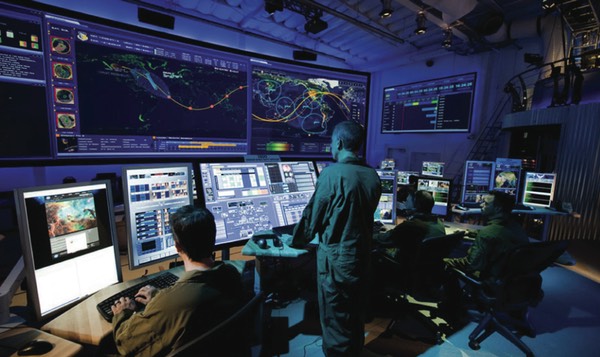Giving the tiger teeth: improving the space operations centerby Joseph T. Page II
|
| The fault of the JSpOC’s inefficiencies is based on mission creep and organizational transformations to meet increasing mission priorities. |
What the US national security space establishment needs are a “spotter” and a “shooter”: a coordinated pair of organizations that observe and track space objects, while determining strategy and enabling (or enacting) tactical action. Some pieces already exist at Vandenberg, in the form of the JSpOC and its predecessor location, now designated the “Alternate JSpOC.”
Why the JSpOC?
Space capabilities are indispensable to joint and combined military operations in that they simultaneously provide global space services and regional space effects to national leaders, the commander of the United States Strategic Command, and geographic combatant commanders across the spectrum of conflict. Simply put, space-based systems either provide a service (e.g. GPS, DMSP weather satellites) or provide an effect (e.g. anti-satellite weapons). While many air-centric coordination centers exist, in the form of Air Operations Centers (AOCs), there is only one officially designated space-centric operations center, the JSpOC.
The fault of the JSpOC’s inefficiencies is based on mission creep and organizational transformations to meet increasing mission priorities. Nothing will kill organizational effectiveness faster than trying to do everything and forgetting your raison d'être, or core business. The fault lies solely in the shoehorning of space operations into the AOC model.
Killing the AOC model
The core of the JSpOC is the 614 Air Operations Center. As listed in Air Force Instruction 13-1 Air and Space Operations Center Volume 3, the 614 AOC is similar in composition to a geographic AOC, but works like a functional AOC for ensuring military space capabilities are brought to bear. The 614 AOC organizational structure includes an AOC Commander (also designated the JSpOC Director) and six divisions: Strategy and Plans; Combat Operations; Intelligence, Surveillance, and Reconnaissance; Unified Space Vault; Space Surveillance; and Operations Support.
There are some major organizational differences between a space “AOC” and an air-centric AOC:
Air-Centric AOC
- Strategy Division (SRD)
- Combat Plans Division (CPD)
- Combat Operations Division (COD)
- Intelligence, Surveillance, Reconnaissance Division (ISRD)
- Air Mobility Division (AMD)
614th AOC / JSpOC
- Strategy/Plans Division (SPD)
- Combat Ops Division (COD)
- Intelligence, Surveillance, Reconnaissance Division (ISRD)
- Space Surveillance Division (SSD)
- Operations Support Division (OSD)
- Unified Space Vault (USV)
Functions that exist within the 614 AOC model, namely Space Surveillance and Unified Space Vault, are duplicated nowhere else in the traditional AOC model. Other organizations, such as Combat Plans Division (CPD) and the Strategy Division (SRD), are combined at the JSpOC into the Strategy/Plans Division (SPD).
| The blunt truth is today the 614 AOC is little more than a space traffic control center. However, this is not a bad thing considering how critical space situational awareness is. |
One challenge SPD faces on a daily basis is matching up to the air-centric ATO’s battle rhythm to all major combatant commands (e.g. Central Command, Pacific Command, Southern Command). The tasking model for an air-centric AOC is called the “Air Tasking Order” (ATO), and is based on a 72-hour cycle. The space version is called the Joint Space Tasking Order (JSTO), and varies in time; from 2005 to 2014, the JSTO cycle varied from 72 hours to 1 week to 3 weeks. Joint Publication 3-14, Space Operations, has in-depth coverage of the JSTO cycle. Attempts to marry up the JSTO cycle with the ATO cycle have had varying results.
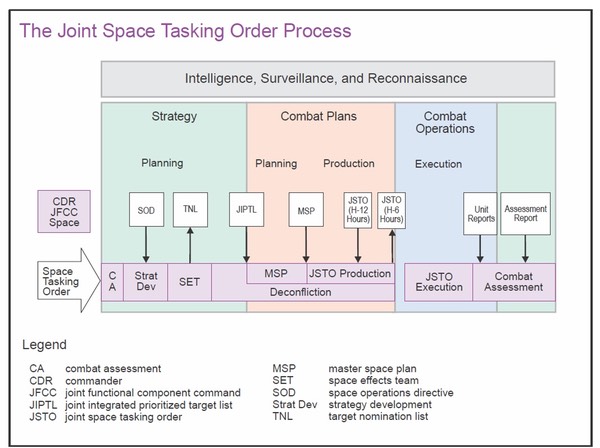 The Joint Space Tasking Order process from JP 3-14, with the superseded separate Combat Plans and Strategy Divisions. (credit: US Department of Defense) |
Air-centric Functional AOCs, such as the Tanker Airlift Control Center and former 623d AOC/AFSOC Operations Center, have adopted organizational structures that fit their mission set, with training equal to training received previously in specific air force specialty codes (e.g. pilots and navigators doing mission planning then moving to the TACC). By contrast, the operations centers supporting US Cyber Command (624th and 625 Operations Center) are named appropriately, without the “AOC” moniker. This difference is critical if for only one reason: not having to follow the structure and procedures in the Air Force Instruction governing AOCs: AFI 13-1 AOCV3, Operational Procedures-Air Operations Center (AOC). Freedom from that construct could provide the inherent flexibility for space operations to become more lethal in a contested warfighting domain.
Synergy of two parts
While space doctrine was more primitive in the 1980s and 1990s, the requisite C2 organization did exist. The organization of space control inside Cheyenne Mountain at the start of the 1990s consisted of a Space Surveillance Center (SSC), a Space Command Center (SPACC), the Joint Space Intelligence Center (JSIC), and the Space Defense Operations Center (SPADOC). As staffing, funding, and priorities shifted, these organizations continually combined and restructured, until the whole was less than the sum of its parts.
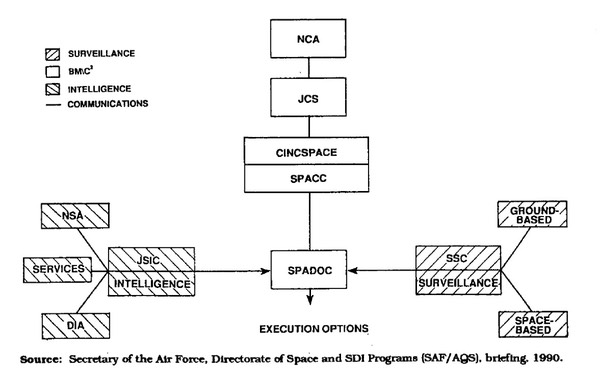 US Space Control organizations, circa 1990 (credit: the Department of the Air Force) |
The blunt truth is today the 614 AOC is little more than a space traffic control center. However, this is not a bad thing considering how critical space situational awareness is. When US and allied forces need to provide rapid response to a space incident, the ability of the AOC is limited at best. 614 AOC personnel with experience during the failed Phobos-Grunt probe to Mars, the Iridium/Cosmos collision, the 2015 DMSP explosion, can attest to activities in preparation for and in response to these events: observe the space domain and report results to higher authorities. However, “observe and report” is not the only response needed in a rapidly changing warfighting environment—it is, in fact, only half of the requirement. An organization that would provide the corresponding half, rapid response (via C2 links and authorities) during a crisis or conflict, is a Fire Direction Center (FDC).
Borrowing from US Army doctrine, an FDC is:
“…a command post, consisting of gunnery and communications personnel and equipment, by means of which the commander exercises fire direction and/or fire control. The fire direction center receives target intelligence and requests for fire, and translates them into appropriate fire direction. The fire direction center provides timely and effective tactical and technical fire control in support of current operations.”
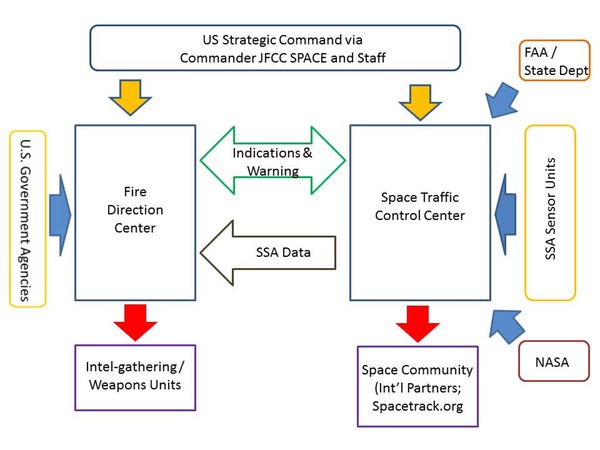 Conceptual Fire Direction Center and Space Traffic Control Center |
The proposed Space FDC, located in the spaces occupied by the Alternate JSpOC, would concentrate on providing a timely response. By being located near decision makers and concentrating solely on the synthesis of crisis events and the intended response, the FDC would provide the ability to rapidly engage space-related crises. Using John Boyd’s O-O-D-A loop, the Space Traffic Control Center would “observe-orient” with SSA data, while the FDC would “decide-act.”
A textbook space operations center
A successful analogy to a true space operations center comes from the National Reconnaissance Office (NRO) in two parts: the NRO’s Satellite Operations Center and the “Blue Cube” in Sunnyvale, California. Both no longer physically exist; they are only footnotes in the history of national security space operations. This, however, does not negate the lessons learned from their decades of support.
First and foremost, the centers had the ability to directly command and control. While this term has been intertwined with military operations for centuries, it is critical in space operations: it defines who has the authority to change a satellite’s orbit or target, in conjunction with the person who sends the command to the satellite.
| While this monitoring of the space environment is crucial, the other half is the ability to directly command and control space assets. It is this area where the current organizations fall short. |
In the early days of space operations, both command and control functions were co-located. National Reconnaissance Program (NRP) satellites, as well as testbeds for the Space Test Program, were commanded out of Sunnyvale’s Blue Cube. Recently declassified documents on the HEXAGON and GAMBIT programs show the importance of the Blue Cube (then known officially as the Satellite Test Center, STC or “stick”). A diagram inside the Hexagon (KH-9) Mapping Camera Program and Evolution history shows how weather, orbital analyses, telemetry, and planning fed into the STC, to be sent out via commands through remote tracking stations around the world. Interestingly, the paragraph describing the “purpose of the STC” was redacted. Additional declassified documents show the HEXAGON Operations Center as part of the STC: a command center, within a C2 facility, for one satellite mission set.
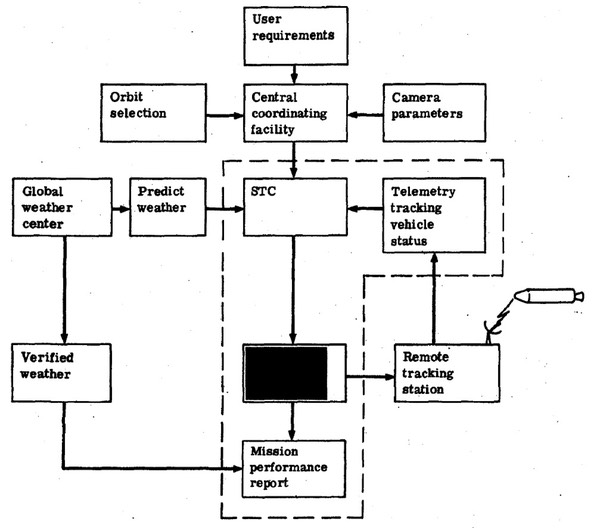 Support from HEXAGON Operations Center at Satellite Test Center, December 1982 (credit: National Reconnaissance Office) |
Data was sent to the STC including mission priorities and strategy. Decisions were made within (influenced by national leaders and staff outside of the building, no doubt), that were translated into commands and sent out via remote tracking stations to command satellites. It was a complete Space C2 node. If a space war broke out during the 1970s or 1980s, this facility would have been a prime battle management command and control center, as well as Cheyenne Mountain Air Force Station.
Comparisons with the Satellite Operations Center (SOC) are a bit thin, due to the lack of substantial information released. Nothing declassified exists about the purpose and operations of the SOC, save for these short statements inside the NRO’s Review and Redaction Guide from 2012:
“Release fact of the Satellite Operations Center (SOC) located in the Pentagon and generic information surrounding its function of forwarding collection requirements from the U.S. Intelligence Board (USIB) for implementation/tasking by the satellite ground stations.”
“Release the fact that the NRO Satellite Operations Center (SOC) in the Pentagon coordinated tasking of the POPPY satellites against the collection requirements of the U. S. Intelligence Board (OSIB). Naval Security Group Headquarters retained responsibility for operating the Control Center that translated the SOC's interpretation of Intelligence Community instruction into commands for the satellite.”
“The NRO Satellite Operations Center. Located in the Pentagon in the early 1960s, it translated the collection requirements levied by the intelligence community for tasking by the satellite ground stations. It was disestablished in the late 1970s.”
These short snippets show that the SOC was located near national decision-makers (i.e. the Pentagon), it was a clearinghouse for USIB taskings, and it coordinated the commanding for the satellites with the operators, NSG HQ. All levels of conflict, strategic to operational to tactical, were working together.
A slow-moving train wreck
In comparison to these historical examples, the 614 AOC has been a slow-moving train wreck from its inception. The AOC grew from a 37-member unit (614 Space Ops Flight), to a squadron (614 Space Ops Squadron) then a group (614 Space Ops Group). Merging with the joint team in 2005, the 614 AOC formed the core of the Joint Space Operations Center (JSpOC). Soon after its inception, a 2006 article by Major Robert Reiss pointed out an overwhelming fallacy in the center: lack of authority:
“Providing the [JSpOC] Director with his information flow, the Joint Space Operation Center […] is supposed to operate at all levels of war (strategic, operational and tactical). But in its current form, Joint Space Operation Center does not carry enough weight to authoritatively deal with all agencies required. The head of the Joint Space Operation Center has Global Space Coordinating Authority, which amounts to little for the joint fighting force and has no influence beyond Air Force Space assets, equaling the uselessness provided by the Director of Space Forces but on a global scale. Coordination authority has no teeth; it is only a short-term solution.”
Where now, space warrior?
Since 2005, the creation of the Joint Force Component Command for Space (JFCC Space) and its three-star general officer commanding has rectified part of the authority problem. The global space coordinating authority now encompasses other services space assets. Responsiveness for issuing orders to tactical units has improved greatly from early inception.
Now the challenge resides in coordination (and C2) of other assets: civil, commercial, and allied spacecraft. The core mission of the 614 AOC has been primarily space situational awareness. Chasing the elusive concept known as control, the unit has morphed into a space monitoring organization, watching as satellites are hit with space debris (2009 Iridium/Cosmos collision), cause space debris (February 2015 DMSP explosion) or space tests are conducted by foreign nations (Chinese ASAT tests in 2007 and 2014).
While this monitoring of the space environment is crucial, the other half is the ability to directly command and control space assets. It is this area where the current organizations fall short. Acknowledging that space is a warfighting domain by creating a warfighting organization—in name, concept and execution—can allow the US to regain the space superiority it once held.
